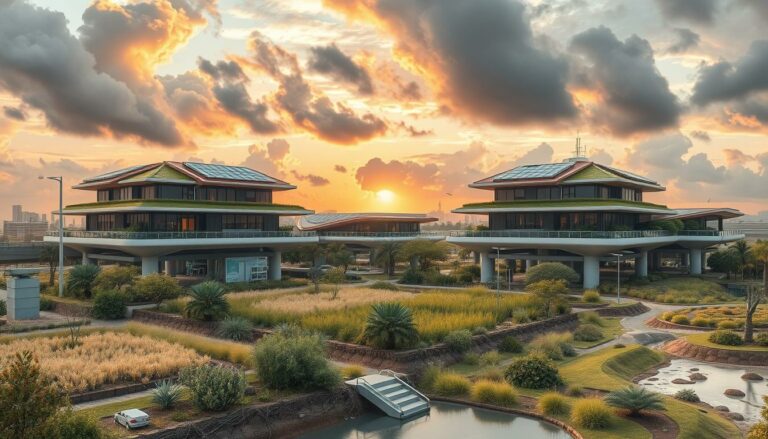Climate change is changing our world, leading to more frequent and severe weather. We’ve seen record-breaking hurricanes and devastating wildfires. These disasters are now the norm. As carbon pollution traps more heat, global temperatures keep rising, making climate change preparedness more urgent.
Communities across the United States face new challenges in disaster readiness. The Department of Homeland Security (DHS) sees this change and stresses the need for climate resilience. They focus on protecting vulnerable communities from climate change’s impacts.
The future of preparedness is about adapting to these changes. DHS is working on five strategies, including empowering communities to build resilience. They aim to protect the homeland and increase national resilience, especially focusing on environmental justice.
Climate impacts on emergencies are clear. The transportation sector is now the biggest emitter of greenhouse gases. Yet, there’s hope. Wind and solar energy costs have dropped, with 80% of new energy coming from renewables. These changes are key in our fight against climate change and its effects on disaster preparedness.
Key Takeaways
- Climate change is causing more frequent and severe weather events
- DHS is focusing on building climate resilience and disaster readiness
- Environmental justice is a key consideration in preparedness strategies
- Renewable energy sources are growing, supporting emissions reduction
- Innovation is crucial for enhancing climate change preparedness
Understanding Climate Change and Its Impact
Climate change is changing our world fast. We need new ways to adapt and be resilient against extreme weather. Rising temperatures and changing weather patterns bring big challenges that we must tackle now.
What is Climate Change?
Climate change means big changes in weather and temperatures over time. It’s caused by human actions that release more greenhouse gases, making the planet warmer. This change impacts ecosystems, weather, and human societies all over the world.
Key Indicators of Climate Change
Many signs show that climate change is real:
- Rising sea levels
- Melting glaciers
- More extreme weather events
- Higher global temperatures
Brief History of Climate Change
Scientists have studied climate change for over a century. Here’s a quick look at the timeline:
| Year | Event |
|---|---|
| 1824 | Joseph Fourier discovers the greenhouse effect |
| 1896 | Svante Arrhenius calculates human CO2 emissions could warm Earth |
| 1960s | First computer models predict global warming |
| 1988 | IPCC established to assess climate change |
| 2015 | Paris Agreement signed to limit global temperature rise |
Now, it’s key to reduce our carbon footprint to fight climate change. With more disasters happening, we must develop strong strategies to adapt and be resilient. It’s not just a choice—it’s crucial for our survival.
The Importance of Climate Change Preparedness
Climate change is changing our world fast. We need to act quickly to reduce disaster risks and protect our environment. With more extreme weather, being ready is not just a good idea. It’s a must for our safety and happiness.
Why Preparedness is Crucial
Climate change is already showing its effects. In the U.S., up to 13 million people might face flooding soon. Droughts are getting worse, and disasters have hit 2.5 billion people worldwide in ten years. These facts show we need strong plans to be ready.
Benefits of Being Prepared
Being prepared has many benefits against climate challenges:
- Less loss of life and property damage
- Stronger communities
- Safe for the most vulnerable
- Better handling of extreme weather
Cities like Austin are leading the way. They suggest having enough supplies for seven days and update buildings for harsh weather. These actions show how being prepared can protect us and our planet.
“Preparedness is the key to resilience in the face of climate change. It’s not just about surviving; it’s about thriving in a changing world.”
By focusing on disaster prevention and environmental care, we can build a stronger future. It’s time to make preparedness a key part of fighting climate change.
Assessing Vulnerabilities in Your Community
Understanding your community’s weaknesses is key to building climate resilience. This process involves pinpointing areas at risk and evaluating available resources. Let’s explore how to conduct a thorough assessment.
Identifying High-Risk Areas
Start by mapping out zones prone to climate-related hazards. This includes areas vulnerable to flooding, wildfires, or extreme heat. Consider factors like topography, infrastructure age, and population density. For coastal communities, focus on coastal resilience strategies to combat rising sea levels and storm surges.
Community Resource Assessment
Evaluate your community’s capacity to respond to climate challenges. This includes assessing emergency services, healthcare facilities, and evacuation routes. Don’t forget to consider social vulnerabilities, such as elderly populations or low-income neighborhoods that may need extra support.
Climate-smart agriculture plays a crucial role in community resilience. Assess local farming practices and their adaptability to changing weather patterns. This can help ensure food security during climate-related disruptions.
| Vulnerability Factor | Assessment Method | Importance |
|---|---|---|
| Flood-prone areas | Topographical mapping | High |
| Heat islands | Urban heat mapping | Medium |
| Coastal erosion | Shoreline surveys | High (for coastal areas) |
| Agricultural resilience | Crop vulnerability studies | High |
By thoroughly assessing these vulnerabilities, communities can develop targeted strategies to enhance their climate resilience. This protects their most at-risk assets and populations.
Developing a Climate Action Plan
Creating a climate action plan is key for communities to tackle climate change. It involves setting clear goals and working together with residents, businesses, and local government.
Setting Clear Objectives
A good climate action plan starts with clear goals. These goals should aim to cut down greenhouse gas emissions and make communities more resilient. For example, the Jamestown S’Klallam Tribe has a plan that focuses on protecting salmon habitats and managing wildfire risks.
Community Involvement and Collaboration
Getting community members involved is crucial for a good climate action plan. The North Olympic Development Council has a list of strategies for ecosystems, water, and infrastructure. They also identify who should be involved and when.
Green infrastructure and ecosystem-based adaptation are important in these plans. They help manage stormwater, reduce heat, and protect wildlife. For instance, Bremerton’s Shoreline Master Program promotes development that considers sea level rise.
| Strategy | Benefits | Examples |
|---|---|---|
| Green Infrastructure | Improves water quality, reduces flooding | Rain gardens, permeable pavements |
| Ecosystem-based Adaptation | Enhances biodiversity, mitigates climate impacts | Wetland restoration, urban forests |
| Community Engagement | Builds local support, taps into local knowledge | Workshops, citizen advisory committees |
By using these strategies and involving the community, cities and towns can make strong climate action plans. These plans help meet both immediate needs and long-term goals for resilience.
Emergency Preparedness Kits: What to Include
Creating a well-stocked emergency kit is key for disaster readiness. As climate impacts on emergencies grow, the right supplies can greatly improve your safety and comfort during tough times.
Essential Supplies for Every Kit
A basic emergency kit should include:
- Water: One gallon per person per day
- Non-perishable food for several days
- First aid kit
- Battery-powered radio
- Cell phone with chargers
- Flashlights and extra batteries
- Whistle to signal for help
- Dust masks and plastic sheeting
- Personal sanitation items
- Manual can opener
- Local maps
Don’t forget to add prescription medications, infant care products, and pet supplies if you have them. Store important documents in a waterproof container. Keep canned food in a cool, dry place and replace expired items often.
Customizing Kits for Different Climates
Climate change is making disasters more common, so you need to tailor your kit. Customize your kit based on local risks:
| Climate | Additional Items |
|---|---|
| Hot | Extra water, sunscreen, cooling packs |
| Cold | Warm clothing, blankets, hand warmers |
| Flood-prone | Waterproof containers, inflatable raft |
| Wildfire-prone | N95 masks, goggles, fire extinguisher |
Keep smaller kits in your car and workplace. Update your supplies every year, thinking about your family’s changing needs. By preparing well, you boost your resilience against climate-related emergencies.
Training and Educating the Public
Teaching people about climate change is key. It helps communities get ready for environmental challenges. This way, we can build a stronger society together.
Workshops and Seminars
FEMA runs over 50 training courses at the Center for Domestic Preparedness. These focus on managing incidents and responding to emergencies. This is crucial for facing climate change.
The National Fire Academy also trains local fire and emergency services. They learn leadership and technical skills. This ensures our first responders are ready for climate-related emergencies.

Partnering with Local Schools
UNESCO’s Climate Change Education program aims to teach young people about climate. This helps future generations understand environmental sustainability. Schools can work with groups like the Rural Domestic Preparedness Consortium to teach homeland security.
The National Network of Public Health Institutes (NNPHI) offers a free climate and health training. This can be used in schools to teach students about climate change and health.
| Training Program | Focus Area | Target Audience |
|---|---|---|
| FEMA CDP Courses | Incident Management | Emergency Responders |
| UNESCO Climate Education | Climate Literacy | Young People |
| NNPHI Climate Training | Climate and Health | Public Health Professionals |
By combining these educational efforts, we can tackle climate change from all angles. This approach involves all age groups and parts of society.
Leveraging Technology in Preparedness
The digital age has brought new tools for disaster risk reduction and extreme weather resilience. Modern technology helps us track, predict, and respond to emergencies faster than ever.
Tools for Disaster Monitoring
Satellite imagery and AI models are key in disaster monitoring. They track weather and predict hazards with high accuracy. For instance, IBM’s Deep Thunder gives detailed forecasts up to 84 hours ahead, for areas as small as 0.2 miles.
Seismographs record ground motion during earthquakes, and sensor networks check infrastructure. The National Hurricane Center uses buoys, radar, and satellites to track hurricanes. This improves early warning systems, crucial for extreme weather resilience.
Apps for Emergency Communication
Mobile apps are vital in disaster preparedness. They offer real-time updates and emergency instructions. The American Red Cross’s AI chatbot, “Clara,” engaged with over 2 million users in its first year, giving tailored disaster advice.
In Odisha, India, an AI system called “SATARK” helped evacuate over 1.2 million people in 24 hours before Cyclone Fani hit in 2019. This shows how technology can greatly improve disaster risk reduction efforts.
| Technology | Impact |
|---|---|
| AI-powered early warning systems | Helped evacuate 50,000 residents during 2023 California wildfires |
| IoT-based flood monitoring | Saved estimated 4,500 lives in Bangladesh’s 2022 monsoon season |
| FireCast system (NYC) | Reduced emergency response times by up to 30% |
As disasters grow more frequent and severe due to climate change, using these technologies is key to building resilient communities.
The Role of Local Governments
Local governments are leading the fight against climate change. They protect communities from its effects. Cities and towns in the U.S. are working hard to keep their people safe.
Policy Implementation and Funding
Cities are making laws to get ready for climate change. For example, New York City has a $4.2 billion Green Bond for climate projects. This helps fund important upgrades while caring for the environment.
Local governments are finding new ways to pay for things. In Massachusetts, coastal towns might lose money because of sea level rise. Boston gets 74% of its budget from property taxes, so it’s important to protect these. They’re using green bonds and working with private companies to fund projects.
Building Resilient Infrastructure
Building green infrastructure is a big deal for local governments. They focus on flood-resistant buildings, green spaces, and eco-friendly transport. These steps help protect against disasters and make life better for everyone.

Cities are also working on advanced early warning systems. These systems send alerts when danger is near, saving lives and reducing damage. By combining these systems with green urban planning, cities are becoming more resilient against climate change.
Climate Change and Mental Health
Climate impacts on emergencies are not just physical. They also affect our mental health. As we prepare for disasters, it’s key to understand the mental effects of climate change.
Understanding Psychological Impacts
Events linked to climate can cause mental health problems. These include anxiety, depression, and PTSD. The effects are especially harsh after sudden weather events like hurricanes or floods.
Long-term environmental changes also have a big impact. Droughts and rising sea levels can make people feel lost and question their identity. A WHO survey shows that only 9 out of 95 countries include mental health support in their climate plans.
Support Systems and Resources
Dealing with the mental health effects of climate change needs a broad approach. Governments and groups are working on strategies to help. These include:
- Improving access to mental health services
- Integrating mental health into disaster risk reduction plans
- Providing community-based support systems
- Offering specialized interventions for climate-related trauma
But, there’s still a big gap. In low and middle-income countries, 3 out of 4 people with mental health issues can’t get the help they need. Closing this gap is vital for better disaster readiness and lessening climate impacts.
| Mental Health Impact | Climate-Related Cause | Intervention Strategy |
|---|---|---|
| Anxiety and Depression | Long-term environmental changes | Community support groups |
| PTSD | Acute weather events | Trauma-focused therapy |
| Identity Loss | Displacement due to climate change | Cultural preservation programs |
Looking Ahead: The Future of Climate Preparedness
The future of preparedness is changing fast as we deal with climate change. We’re seeing new ways to work together and find solutions.
Innovations in Emergency Management
Colorado has made big steps in getting ready for climate change. They’ve created a roadmap focused on adaptation. This plan will be updated every three years to keep Coloradans safe from wildfires, floods, and drought.
Collaborative Approaches for Resilience
123 countries have joined forces to fight climate change. The Resilience Action Network Africa (RANA) is a big step towards working together. It shows how important it is to work as a team.
We need to keep working on funding for pandemic prevention. The Pandemic Fund and the Africa Epidemic Fund are key. Colorado and Denver are planning to make their communities more climate-ready by 2025. The future looks bright with innovation, teamwork, and resilience.
FAQ
What is climate change and how does it affect disaster preparedness?
Climate change means big changes in weather patterns and temperatures over time. It leads to more intense weather like hurricanes, wildfires, and floods. We need to update our disaster plans to protect people and property from these changes.
Why is climate change preparedness crucial?
Being ready for climate change helps save lives and property. It makes communities stronger against extreme weather. In today’s world, getting ready is key for a safe future.
How can communities assess their climate change vulnerabilities?
Communities can find out where they’re most at risk by looking at flooding, wildfires, and other dangers. They should check their buildings, emergency plans, and how people might be affected. Knowing these risks helps make better plans to stay safe.
What should be included in a climate change emergency preparedness kit?
A good kit has food, water, first-aid, and ways to communicate. Make sure it fits your area’s climate risks. For example, add extra water for hot places or cold gear for winter storms. Keep it ready and check it often.
How can technology be leveraged for climate change preparedness?
Technology is very important for getting ready for disasters. It helps track weather, predict dangers, and talk to people in emergencies. Tools like satellite images and apps give updates and help us act fast.
What role do local governments play in climate change preparedness?
Local governments are key in getting ready for climate change. They make rules, get money, and build strong buildings. They should think about climate when planning cities and buildings to keep communities safe.
How does climate change affect mental health, and what resources are available?
Climate change can make people feel anxious, sad, and stressed. These feelings come from disasters or worrying about the future. There are places to get help, like counseling and support groups, to deal with these feelings.
What does the future of climate preparedness look like?
The future will bring new ways to manage emergencies and work together to be stronger. We’ll use new tech and share ideas worldwide. The goal is to build communities that can face and bounce back from climate challenges.
Source Links
- https://www.dhs.gov/sites/default/files/publications/dhs_strategic_framework_10.20.21_final_508.pdf
- https://nca2023.globalchange.gov/
- https://www.samhsa.gov/find-help/disasters/climate-change-health-equity
- https://www.un.org/en/climatechange/climate-adaptation
- https://www.undrr.org/implementing-sendai-framework/drr-focus-areas/climate-action-and-disaster-risk-reduction
- https://www.nrdc.org/issues/climate-adaptation
- https://www.austintexas.gov/page/climate-preparedness
- https://www.icrc.org/en/doc/assets/files/other/climatechange_report_final_eng.pdf
- https://www.canada.ca/en/health-canada/services/publications/healthy-living/climate-health-adapt-vulnerability-adaptation-assessments-resource-guide.html
- https://www4.unfccc.int/sites/NAPC/Country Documents/General/apf technical paper03.pdf
- https://www.cambridgema.gov/CDD/Projects/Climate/climatechangeresilianceandadaptation.aspx
- https://mrsc.org/explore-topics/environment/sustainability/climate-preparedness
- https://www.whitehouse.gov/prepare
- https://www.ready.gov/kit
- https://www.fema.gov/blog/10-items-include-your-emergency-kit
- https://www.un.org/en/climatechange/climate-solutions/education-key-addressing-climate-change
- https://nnphi.org/focus-areas-service/climate-and-crisis-preparedness/
- https://www.fema.gov/emergency-managers/national-preparedness/training
- https://www.preventionweb.net/news/transforming-disaster-preparedness-role-tech-responding-climate-shocks
- https://www.linkedin.com/pulse/from-data-action-leveraging-ai-iot-disaster-preparedness-response-6yr3c
- https://publichealth.tulane.edu/blog/technology-disaster-management/
- https://icma.org/blog-posts/climate-emergency-preparedness-local-governments
- https://rmi.org/supporting-local-governments-as-climate-change-threatens-their-communities/
- https://www.who.int/news/item/03-06-2022-why-mental-health-is-a-priority-for-action-on-climate-change
- https://pmc.ncbi.nlm.nih.gov/articles/PMC7698950/
- https://pmc.ncbi.nlm.nih.gov/articles/PMC9762138/
- https://www.pandemicactionnetwork.org/news/looking-ahead-from-fragility-to-resilience-in-2024/
- https://goco.org/news/releases/what-theyre-saying-following-release-of-climate-preparedness-roadmap

